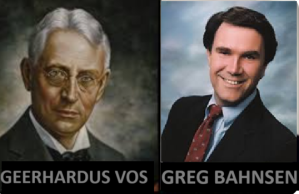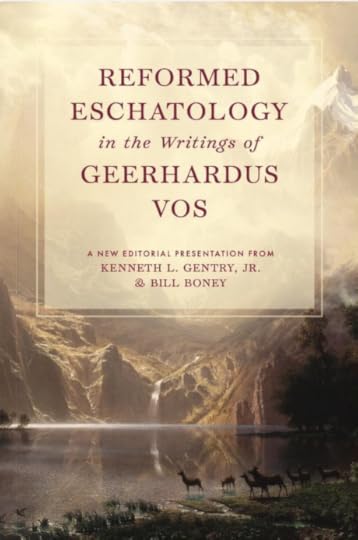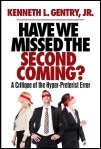When Does the “Already” End?
PMW 2025-072 by Ardel Caneday
Gentry Note:
This article on the Two-Age redemptive historical scheme is quite helpful. After reading it, I wrote to Dr. Caneday (my old Grace Seminary friend) to let him know that not all postmills agree with Wilson and Brito on the matter. In fact, I follow Bahnsen in subscribing to Vos’ Two-Age view while maintaining the posmillennial hope. I am currently working on a book on the topic. If you would like to financial contribute to this project, please see my final note below. Even if you would not like to contribute, I hope you will before my hitmen set sail towards your house. But now for Caneday’s article:
“Already But Not Yet”: When Does the “Already” End? When Christ Returns or When Jerusalem’s Temple Was Destroyed?
by Ardel Caneday
Within my lifetime, not only academics but lay people also have become increasingly familiar with “the already but not yet”—the biblical concept of the overlapping of two ages—the present age and the age to come. This became evident when “Progressive Dispensationalism” emerged with the publication of Dispensationalism, Israel and the Church (1992). A feature that distinguishes this newer form of dispensationalism is the belief that Christ Jesus already reigns, fulfilling the promise to David (Psalm 110), but not yet are all his enemies put under his feet. Hence, concerning Christ’s reign, “inauguration is present, but consummation is not.”[1] While distinguishing their view from “Classical Dispensationalism,” they also contended that their “formulation of ‘the already, not yet’ kingdom” was different from George Ladd’s.[2] Nevertheless, they set in motion rapprochement with non-dispensationalists that accelerated profitable conversations among scholars from both views throughout the past thirty years.[3]
“Already But Not Yet”—The Overlapping of Ages Between Christ’s Comings
Dispensationalism, Israel and the Church (edited by Craig A. Blaising and Darrell L. Bock) engages with George Ladd, but never mentions Geerhardus Vos. Ladd learned from Vos “the already but not yet” structure of the New Testament writers’ presentation of Christ’s inaugurated reign that awaits consummation. Vos extensively developed Christ’s “already but not yet” dominion in The Pauline Eschatology, where “eschatology” is not a reference to “the last things” as a systematic theology category. Rather, Vos uses “eschatology” to encompass the entirety of the Apostle Paul’s theological teaching concerning redemption in Christ Jesus.[4] Thus, Vos teaches us to recognize that when the OT prophets saw in advance the Messiah’s sufferings and subsequent glory, they were not given the insight that the salvation they prophesied would arrive not in one, but two phases (cf. 1 Pet. 1:10–12). So, at the Messiah’s advent, the glorious realm the prophets anticipated would reach its exhaustive fulfillment in fact did not end. Instead, Christ begins this new creation (Gal. 6:15; 2 Cor. 5:17). He set in motion the age to come without ending this present evil age (Gal. 1:4; Eph. 1:21). All who are in Christ Jesus are already inhabiting the age to come in as much as God the Father “has blessed us in Christ with every spiritual blessing in the heavenly places” (Eph. 1:3).
Reformed Eschatology in the Writings of Geerhardus Vos
Ed. by Ken Gentry and Bill Boney
This is a collection of several key eschatological studies by the renowned Reformed theologian Geehardus Vos. We have modernized Vos’ grammar and syntax and updated his layout style according to modern publishing conventions (shorter sentences and paragraphs). We did this without changing any of Vos’ arguments.
For more information on this new Vos work or to order it, see:
https://www.kennethgentry.com/reformed-eschatology-in-the-writings-of-geerhardus-vos/
New Testament readers, whether Reformed or non-Reformed, Protestant or Catholic, have recognized this “already but not yet” structure and dynamic. This “already but not yet” dynamic concerns the presence of the future which is bound up fully with Christ’s advent. Thus, we should not speak of the “already but not yet” as a matter of degrees. It is not as if the coming age of salvation (brought forward into the midst of history when Christ came) is already partially here and partially not yet come. Instead, the perspective the NT writers present is that Christ Jesus has already inaugurated the new creation, which he will fully consummate when he returns. Thus, the glorious blessings of the coming age come to us in two phases. The already phase is anticipatory of the not yet phase. As the new moon anticipates the full moon, Christ’s first coming is a portent of his second advent (Acts 1:11). We are already inhabiting the inaugurated phase of the promised age of salvation while we await the consummated phase when Christ returns. We already experience the resurrection life in the resurrected Christ even as we inhabit this present evil age (Gal 1:4). By way of the preaching of the good news, through faith in Christ, we already receive the justifying verdict in advance of the Day of Judgment as we “eagerly wait for the hope of righteousness” (Gal. 5:5; cf. Matt. 12:36-37).
Focusing on the Apostle Paul’s letters prompts us not only to recognize how frequently we come upon “the already by not yet” dynamic but also how instructive it is. Consider the following.
• We are already adopted in Christ Jesus (Rom. 8:15), but not yet adopted (Rom. 8:23).
• We are already redeemed in Christ Jesus (Eph. 1:7), but not yet redeemed (Eph. 4:30).
• We are already sanctified in Christ Jesus (1 Cor. 1:2), but not yet sanctified (1 Thess. 5:23–24).
• We are already saved in Christ Jesus (Eph. 2:8), but not yet saved (Rom. 5:9; 13:11);
• We are already raised with Christ Jesus (Eph. 2:6), but not yet raised (1 Cor. 15:52).[5]
Vos teaches us, then, to conceive of two ages or two realms coexisting with one another since the advent of Christ Jesus. With his resurrection, Christ brought forward the powers of the coming age (cf. Heb. 6:5), including resurrection and judgment, activating these powers within this present age.[6] Many have reproduced Vos’s charts that portray how the age to come now overlaps the present age since the advent of our Lord.[7] Readers of the ESV Study Bible will find a variation of Vos’s two diagrams.[8] Below is my own representation of Vos’s portrayal of how the OT prophets anticipated the salvation that Messiah’s coming would bring, followed by the structure updated by Christ’s coming.
Three Views on the Millennium and Beyond
(ed. by Darrell Bock)
Presents three views on the millennium: progressive dispensationalist, amillennialist, and reconstructionist postmillennialist viewpoints. Includes separate responses to each view. Ken Gentry provides the postmillennial contribution.
See more study materials at: www.KennethGentry.com
“Already But Not Yet”—Only Forty Years of Overlapping Ages?
Recently, partial preterists, who embrace post-millennialism, have modified this portrayal of the NT’s teaching concerning “the already and the not yet.” Consider, last month’s podcast with Doug Wilson concerning the nature of Christian Nationalism. Among various pertinent questions asked of Doug Wilson, David Schrock inquired,
“What for you is the mission of the church and, connected to that, how does your understanding of the two ages fit with that? Is there an already and not yet understanding? Certainly in things that I’ve read from you, you’ve said the overlap of the ages took place between the ascension of Christ and the destruction of Jerusalem. Help us understand that and the mission of the church (Interview with Doug Wilson on Christian Nationalism).”
Doug Wilson replied,
Okay, so very quickly on the ages. I think the Old Testament era—I call it the Judaic age—ended cataclysmically in 70 A.D. I think the Christian Aeon, or the Christian Age, was inaugurated 40 years before the Judaic Age ended. It was like a baton exchange in a relay race.
So, there were roughly 40 years when the two ages were running concurrently, and then the temple was destroyed, and we were into the Christian aeon. I would say that the already-not yet aspect of it has to do with the eternal age to come, so after the Lord Jesus returns. The Lord has been raised from the dead so that the end of the world happened in the middle of history. That’s the already. But then the general resurrection of the dead is the not yet.
So that’s the general pattern of the sketch for the ages.
Given Wilson’s response, the chart below illustrates what he believes concerning the “already but not yet”:
On his own blog, Wilson fills out some details concerning “the not yet” aspect. He explains that because of Adam’s disobedience, the Creator afflicted the created order with corruption. Creation’s liberation from this bondage will come about only when we, Christ’s people, receive our “not yet” adoption as God’s sons (Rom. 8:23). Thus, the entire creation groans with the pains of childbirth, pregnant with expectation, eagerly “longing for the revealing of the sons of God” (Rom. 8:19). Wilson says,
This is the world that is pregnant with a future glory. So we do not believe that an external force is going to come down at the end of time and zap everything to make it different. We believe He already came down, and He already rose in the middle of history, such that things are already different—just as a pregnant woman is already a mother and not yet a mother. The transformation of the cosmic order is working its way out from the inside. A decaying world was infected with radical life and the infection site was a tomb outside Jerusalem.
Have We Missed the Second Coming:
A Critique of the Hyper-preterist Error
by Ken Gentry
This book offers a brief introduction, summary, and critique of Hyper-preterism. Don’t let your church and Christian friends be blindfolded to this new error. To be forewarned is to be forearmed.
For more Christian educational materials: www.KennethGentry.com
Wilson believes the destruction of Jerusalem and the Temple ended what he calls “the Judaic age” in A.D. 70. Consequently, the overlapping of the two ages spanned only about forty years. So, Wilson significantly reconfigures Vos’s conception of the two realms or ages. His version of Vos’s schema terminates the line representing this present age at A.D. 70, instead of at Christ’s second advent. Wilson relabels the time of Christ’s death and resurrection to the destruction of the temple in 70 A.D. as “the Judaic age,” instead of “this present age.” Likewise, he labels the time of Christ’s death and resurrection until the second coming as “the Christian Age,” instead of “the Age to Come.” Hence, his diagram does not capture the intersection of the vertical and horizontal dimensions as Vos’s does. Nevertheless, Wilson insists that Christ’s resurrection already invades the present with transformative power.
A decade ago, Uri Brito wondered how using the language of “already but not yet” was beneficial to the postmillennial explanation of “the victorious promise of the gospel.” He suggested that . . . .
To read full article with footnotes: https://christoverall.com/article/concise/already-but-not-yet-when-does-the-already-end-when-christ-returns-or-when-jerusalems-temple-was-destroyed/
GOODBIRTH AND THE TWO AGES
I am currently researching a technical study on the concept of the Two Ages in Scripture. This study is not only important for understanding the proper biblical concept of the structure of redemptive history. But it is also absolutely essential for fully grasping the significance of the Disciples’ questions in Matthew 24:3, which spark the Olivet Discourse. This book will be the forerunner to a fuller commentary on the Olivet Discourse in Matthew’s comprehensive presentation. This issue must be dealt with before one can seriously delve into the Discourse itself.
If you would like to support me in my research, I invite you to consider giving a tax-deductible contribution to my research and writing ministry: GoodBirth Ministries. Your help is much appreciated! https://www.paypal.com/donate/?cmd=_s-xclick&hosted_button_id=4XXFLGKEQU48C&ssrt=1740411591428
Kenneth L. Gentry Jr.'s Blog
- Kenneth L. Gentry Jr.'s profile
- 85 followers



